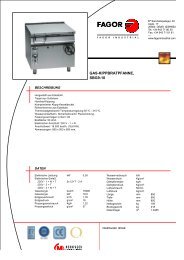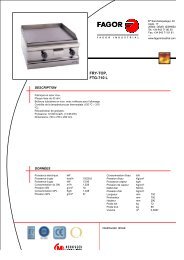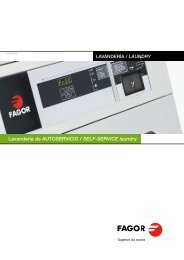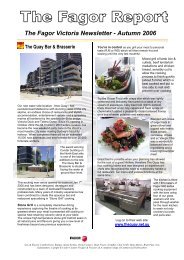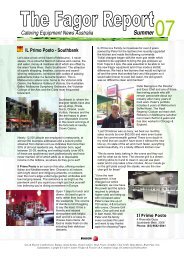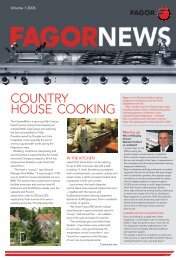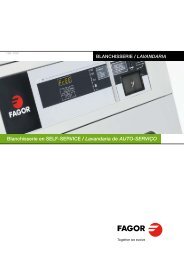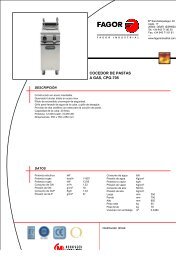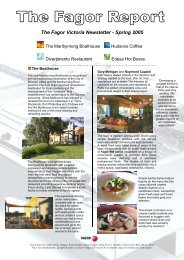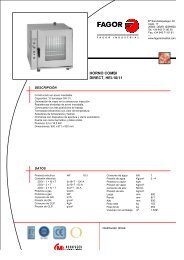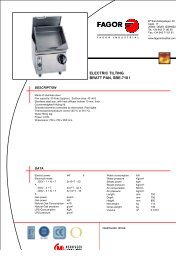Download - Fagor Industrial
Download - Fagor Industrial
Download - Fagor Industrial
You also want an ePaper? Increase the reach of your titles
YUMPU automatically turns print PDFs into web optimized ePapers that Google loves.
FAGORNEWS 2013 TOGETHER WE EVOLVE FAGORNEWS 2013<br />
TOGETHER WE EVOLVE<br />
Three areas in 700 square metres<br />
Consequently, the 340 square metre laboratory<br />
was enlarged to 700 square metres, and<br />
three different areas were pooled together<br />
in this space. the development laboratory,<br />
the reliability laboratory and the certification<br />
laboratory. In addition there is a training<br />
area for the technicians and mechanics from<br />
the Technical Assistance Service (SAT) and<br />
an area for packing and transport analysis.<br />
These zones respond to the four product lines<br />
manufactured at Oñate: washer extractors,<br />
ovens, cookers and dishwashers. The first<br />
zone is the development zone, occupying 200<br />
square metres and allocated to the department<br />
of R&D, which is the team responsible<br />
for designing and developing new products<br />
to launch on the market. “From the moment<br />
when the idea is born until the product is finally<br />
marketed, at least two years go past”, reveals<br />
Urcelay. During this period, designs are<br />
drawn up, prototypes are made and our rivals’<br />
products are subjected to all types of tests, to<br />
compare and contrast solutions, performance<br />
and operation.<br />
In this respect, Urcelay admits that “one important<br />
aspect that we wished to reinforce<br />
with the project is finding out more about our<br />
rivals’ products. Major efforts have been made<br />
to define the Key Factors to Competitiveness,<br />
which could be defined as those that are<br />
considered critical for our product offer, and<br />
those on which we base our sales arguments.<br />
Therefore, they are the ones that are subjected<br />
to the strictest tests”. Thus <strong>Fagor</strong> <strong>Industrial</strong><br />
is able to demonstrate with well-founded data<br />
that it has the best product and, if this is not<br />
the case, the results will indicate the areas<br />
requiring improvement to the department of<br />
R&D.<br />
The procedure for launching a new product<br />
is, on the whole, complex. From the<br />
moment work starts on the idea until it is<br />
finally manufactured, up to two years may<br />
go by. The procedure must consider different<br />
factors and achieve the best possible<br />
equilibrium between each one. Aspects to<br />
be considered include the manufacture,<br />
the assembly capacity, the ease of certification,<br />
logistics, functionality, reliability,<br />
that it is easily repairable, that it is easy to<br />
maintain, cost… The designer has to consider<br />
all these factors in a new design and<br />
achieve an equilibrium between each one.<br />
Then there are two areas belonging to<br />
the laboratory as such. One is the Reliability<br />
Laboratory. This name refers to a<br />
space “that has been strengthened considerably”,<br />
according to Urcelay. This zone<br />
measures 200 square metres and different<br />
tasks are carried out there. One such<br />
task is the performance of reliability tests<br />
during the procedure to launch a new<br />
product, a new feature or a new improvement.<br />
Another is to perform reliability tests<br />
on a serial product and the last task is “to<br />
perform validation and approval tests on<br />
a new component or a new supplier with<br />
respect to durability and reliability”, reveals<br />
Urcelay.<br />
42 #11 / JUNE 2013<br />
#11 / JUNE 2013<br />
43






